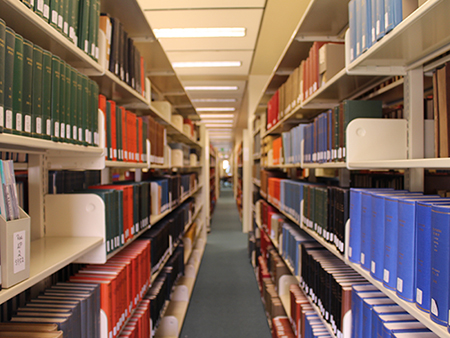Media contact: Yvonne Taunton
 Emma Herr and Chris Bertolini examined Birmingham Public Library newspaper archives from the Nazi period of 1933-1945, focusing on key Holocaust events. Their work will be used by the BHEC and United Stated Holocaust Memorial Museum.
Emma Herr and Chris Bertolini examined Birmingham Public Library newspaper archives from the Nazi period of 1933-1945, focusing on key Holocaust events. Their work will be used by the BHEC and United Stated Holocaust Memorial Museum.
(Photography: UAB Digital Media)The University of Alabama at Birmingham Department of History has partnered with the Birmingham Holocaust Education Center for a research project investigating news archives from three Birmingham newspapers to uncover stories told during the Nazi period of 1933-1945. Student interns Emma Herr and Chris Bertolini are leading the project for the organization, which began in early January.
“It’s interesting to see how newspapers framed this discussion people had about the Holocaust,” Bertolini said. “In the ’30s, newspapers limited information; but now you can get information from every possible source. It is fascinating to see how our relationship with that has changed.”
The Birmingham Holocaust Education Center is a nonprofit organization dedicated to Holocaust remembrance and education throughout Alabama. Ann Mollengarden, education director at BHEC, says the project is a continuation of work she and a colleague started in 2014.
“We wanted to explore what the Birmingham public knew about the events happening in Europe during the ’30s and ’40s; but due to limited time and resources, we started the project focusing on the days and weeks surrounding the Kristallnacht pogrom of November 1938,” Mollengarden said.
Mollengarden says they spent about two months reading through two weeks of newspapers, including The Birmingham News, The Birmingham Post and Birmingham Age-Herald, from the Birmingham Public Library. The research was initially intended for teachers teaching the Holocaust to use as a primary resource, and shortly after examination, they realized the substantial content needed more exploration.
“The local newspapers at the time were a rich resource of international news,” Mollengarden said. “The juxtaposition of articles about the developing terror in Nazi Germany and the debutante balls and social gatherings in Birmingham was surreal.”
In 2016, the United States Holocaust Memorial Museum revealed its latest project, “History Unfolded: US Newspapers and the Holocaust,” a collection submitted by researchers of local newspapers that focused on all mentions of the Holocaust. The BHEC submitted multiple Kristallnacht articles for this project. Newspaper articles from the “History Unfolded” project became their own display in the museum’s latest exhibit, “Americans and the Holocaust.”
“I am almost living through the events as they go, because I am reading newspapers and newspapers, so the developments are coming,” Herr said.
The students used a list of 26 distinct categories provided by USHMM and chronologically split the topics between them. Upon completion, the BHEC will submit the work of Herr and Bertolini to the USHMM. Mollengarden says these are the most amazing students.
“They are so self-motivated and have fallen in love with this project,” Mollengarden said. “They are learning about the Holocaust from their newspaper research, but they are also learning about many other events going on in the United States at the time. We meet regularly on Zoom, and they teach me about the politics and current events going on in Birmingham.”
The decline in newspaper content has Mollengarden wondering what future research will resemble. Researchers will no longer be able to quickly scan a page and get a feel for the important events going on at the time. Online news is categorized by topic and does not offer that type of snapshot.
Mollengarden said, while many people say they were not aware of the events going on in Europe, “we know from these articles that the information was there. We have to think about today’s world and how we react when we learn of atrocities around the globe. Do we read about them and then go to work and about our daily lives with no action? Should we be more involved in world events? How do we get involved? These are the kinds of questions students should explore.”